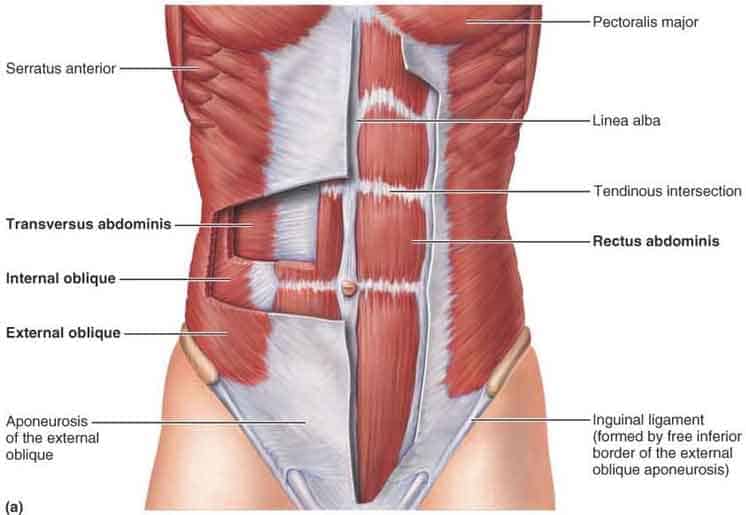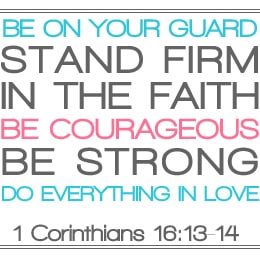If you did not read last weeks post Prenatal Fitness, Diastasis Recti, & Body After Baby you might want to do that before you read further so you have some background on what it is I am discussing.
Medical Disclaimer: I also feel I need to put a disclaimer on this post and let you know I am by no means a medical professional or a diastasis recti expert. I am however a mother, certified personal trainer, and yoga instructor. What I am sharing is based on my own research and experience.
THE TRUTH ABOUT DIASTASIS RECTI & WHY IT MATTERS
When abdominal separation occurs the rectus abdominis (otherwise lovingly referred to by many as the six-pack muscle) is not the only muscle that is affected. It is however what the majority of people notice. Take a look at this picture of the core musculature.
Many of these muscles are attached to the same structures. The reason this is important to note is because when a muscle looses its stability it can cause a ripple effect throughout the entire body.
In the case of diastasis recti, the entire core of the body, glutes, ribs, pelvic floor, and the deeper core musculature become unstable. Diastasis recti can lead to low back pain, pelvic pain, incontinence, prolapse and urinary urgency/frequency. Women who have abdominal separation also tend to have a higher degree of pelvic floor and abdominal pain.
Hopefully you are starting to see this is a much bigger issue then just a bulging tummy. Diastasis recti can also alter the function and insertion of the transversus abdominis and external oblique muscles. The transverse abdominis is located under the obliques. It is the deepest abdominal muscle and wraps around your spine for protection and stability. Think of this muscle as your internal girdle. When this muscle is strong and well developed it will tighten and slim your waistline. But when this muscle is weak it will alter the basic function of many other muscles. This alteration in biomechanics and insertion can lead to abdominal trigger points. Trigger points are common causes of urinary urgency, urinary frequency and pelvic pain.
HEALING YOUR CORE
There are many factors that play into healing your body after having a baby. Here is a quick breakdown.
- By 8-12 weeks postpartum your body has done what it will naturally do on its own. Your uterus has shrunk and whatever amount of abdominal separation you have remaining is most likely where it will stay until you intervene.
- Adjust your thinking about how you are going to go about healing your body. You need to retrain the muscles that have been affected by birthing your baby. Instead of doing a million sit-ups, which by the way won’t do you any good closing your gap, focus on getting back to the basics. Keep reading to see what program I recommend.
- While nobody likes to hear it, there are certain factors that will determine your rate of healing such as age, space between pregnancies, weight gain, nutrition, and genetics.
- Keep in mind that no matter where you are in your post baby journey, maybe you had your baby last week or 10 years ago, there is always a way you can improve. Let me be honest, you might never close your gap completely, but you can always improve it. Don’t give up on yourself.
According to the American Congress of Obstetricians and Gynecologists the average distribution of weight gain during pregnancy is 30 pounds. This increase in weight causes internal pressure inside of the abdominal cavity. The pressure is upward, downward, and outward and is what creates the abdominal separation. Before any exercise this abdominal pressure needs to be addressed. There are several ways you can start addressing the pressure right now by adjusting the alignment of your body.
I am a huge fan and believer in chiropractic care. If you are local and need the name of a great chiropractor go and see Dr. Jason Taylor. He is awesome! Besides seeing a chiropractor there are several things you can do at home to begin to correct your alignment. How we sit, stand, and hold ourselves everyday can be adjusted to begin fixing this pressure.
How to Adjust The Alignment of Your Body
- Resist the urge to tuck your tailbone. Tucking your tailbone shortens the muscles in your pelvic floor and creates more upward pressure in your abdominal cavity.
- Stop sucking in your tummy. Gasp! I know right! But listen and hear me out. I promise this is not just crazy talk. When we suck in our belly’s everything that was hanging out has to go somewhere. So by sucking in we cause more downward pressure on the pelvic floor and further weaken those muscles.
- Relax your shoulders. Try not to hold tension in your upper body. Our entire musculature is interconnected by fascia and when the body becomes tight or tense in one spot it has a direct correlation on another.
- No high heels. When we wear high heeled shoes our alignment shifts forward. Elevating your heels places more of your body’s weight on your toes, which causes your body, particularly your pelvis, to tilt forward. To compensate and stay upright, you unconsciously lean backward and overarch your back, creating a posture that can strain your knees, hips, and low back.
- Find and work the transverse abdominis. Keep reading to see what program I recommend. I will also do a separate post on why this muscle is so important.
- Avoid exercises that open the gap. To see what to avoid read my last post: Prenatal Fitness, Diastasis Recti, & Body After Baby.
There are several programs available that focus on healing diastasis recti. I have looked into many of them. By far the best program that I have found and that I support is the Mutu System. The creator Wendy Powell is simply amazing. This program focuses on retraining the muscles in the body, healing the mommy tummy, and correcting the internal pressure.
You can get a free video with Wendy’s top 10 ab exercises by signing up on her website (top right corner).
The Mutu System offers a 12 week online program and I love it! It never expires and I am currently doing it right now, even during pregnancy. I will also be doing this program after baby girl is born.
I want to thank all of you for reading, commenting, and e-mailing me on this topic. It is nice to know that this information is helpful to you! If you are still wanting more information on diastasis recti please look into Wendy’s program. She is an expert on this topic and has spent years developing the Mutu System to help women reclaim and retrain their bodies after having a baby.
Make sure to share this post with your friends and social network. Let’s get this information out to all the moms we know!
You might also be interested in my Losing The Baby Weight Series! Topics include: Pregnancy & Exercise, What to Expect After Delivery, The First Six Weeks, Nutrition, and Exercise.
Disclosure: I was so impressed with the Mutu System that I decided to become an affiliate for the program.















Tamara, I’ve been following your blog for a while now and I really love it, so thank you! I feel like I always find such great info here! I have also been using MuTu for the past several months (love it!) and I’m so glad you’re addressing diastasis recti here as well. Looking forward to the next follow up post. 🙂
Haven’t had a baby yet, but this is such great information! I had no idea this would happen and that there are steps to take to help get your body back. Thanks for posting! I’ll def be looking back here when the time comes 😉
Do you know of or have any advice for women who are pregnant currently but never healed from their first pregnancy? My kids will be exactly two years apart, pregnant with the second right now, 14 weeks in after a full term pregnancy with an 11lb baby. I’ve had a flat tummy my whole life and am terrified ill never get it back after this baby!! Is there anything I should be doing now or do I just have to wait until after baby and bust my butt then? Thank you in advance for any advice!
Can I ask your opinion of belly bands? My friend just gave me some to try, tho I am 2+ years post postpartum. Do you think it will still work and if so, what is the best way to wear/use it?
I wold love to hear from you in regards to which Mutu system you would recommend for me. If you could email me or comment back. I do not need nutritional help, I weigh less than I did before preganncy and I lift/run 4-5 days a week. But I want the intense workout out like the 12 week program describes, but don’t need the extra stuff. But I seriously look like I’m still 4 months pregnant because of the seperation. My little one is now 8 months old. Thank you so much!
Hi Lindsey, Hopefully this will answer your question. If you already have a workout program that you are doing I would still suggest getting the full program because you will learn what exercises to avoid that might be contributing to your separation not healing. The full 12 week program is so good and you will learn so much! Good luck mama!
Great! Thank you. Do I buy from you or from the site? And also do you suggest the DVD or online program?
You can purchase directly from the Mutu website. I have the online program just because it is easier for me to watch it on my laptop but they are both the same.
Hi Tamara,
How soon after your delivery did you start this program? I know most doctors suggest to wait 4-6 weeks to start working out again but I’ve been very active throughout my pregnancy and this seems like a moderate workout so I’m wondering if it’s something I can start a couple weeks after my baby’s birth? (And of course, I know I’ll need to check it out with my doc, just wondering what you did.) Thanks so much!
Hi Shannon,
I didn’t hear about this program until after my son was a year old. With this second baby I am planning to start within a few weeks of delivery.
Hi there. Just wondering if you have ditched any shoes w/ any heel entirely. I am trying to sort out priorities in this. Thanks much. And thanks for introducing me to this program. I had heard of others but not this one.
Hi! I don’t wear any heeled shoes :). Thanks for reading and I am glad this information was helpful.